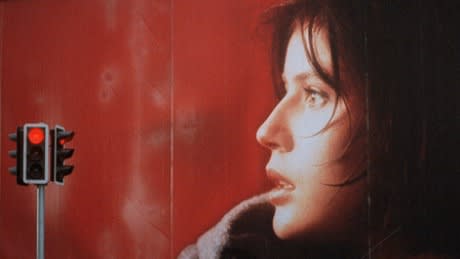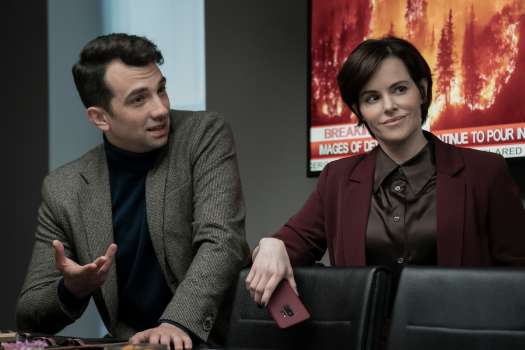Red, the final film in Krzysztof Kieslowki's Three Colours trilogy about contemporary French society (the others being Blue (Liberty) and White (Equality)), is quite possibly the Polish director's penultimate work. He similarly posits dialectic on a broad ideal—in this case, fraternity—with a clever, ironic spin, but injects conflicting ideology and a layered plot structure, creating a puzzle about futility and fate that deliberately contradicts itself.
He does so by telling the story of young Swiss model Valentine (Irene Jacob), living in Geneva and working on a gum campaign, paying the bills with various runway shows while trying to manage her family dynamic from a distance by forcing her heroin-addict teen brother to visit their lonely mother. Hitting a stray dog one night, she is led to its owner—a retired judge (Jean-Louis Trintignant)—who responds with indifference and hostility to her concerns, refusing to assist or take any responsibility for his pet.
Without knowing anything about the older judge beyond his actions in that moment, Valentine is horrified by his character, baffled by his callous treatment of a pet. When she is eventually led back to his home, when her newly acquired pet escapes her arms and runs back to his owner some time later, she is even more disgusted to learn that he spends his time listening to the many phone conversations of all of his neighbours, even though his job is to catch a suspected nearby heroin dealer that uses a phone on another frequency.
Smartly, Kieslowski is careful not to spell out his intentions here. Valentine often hypocritically watches her neighbours—a young judge experiencing romantic woes, mostly—and passes judgment on them, only it's not as directly invasive as tapping phones or scowling at a stranger for helping with an injured pet. The judge asks Valentine to verbalize why she wanted to help the dog—whether it was to help her own conscience or to demonstrate kindness to a stranger—pointing out a different perspective on the nature of human giving.
Initially, the young model is revolted by this stoic, rigid older man, sure that his presumptions about his neighbours are just callous cynicism. But there's something about his lack of will in converting her, something about his indifference to her agreement, which makes her want to understand his motivations. Similarly, he sees himself through her eyes, questioning his existence as a figurative and literal judge, wondering if punishing or ignoring a perceived flaw or error is ever valid or certain.
Symbolism is as much a player as the constant use of blood red imagery that bleeds through every composition in the film. What does it mean to help, or interfere with, others? Is it really helping them, or is it helping oneself? What does it mean to be judged? The many neighbours in the film respond with hostility when they discover the judge has been listening to their conversations. But does their knowledge of his omniscient presence cause them to question their deceptions and infidelities?
Kieslowski raises a lot of questions about the nature of harmonious living and functioning society, turning it all on its head once he posits an oddly fatalistic finale that suggests everything is preordained regardless of ideological speculation. It's this knowing final smirk that indirectly reiterates the sly manner in which the entire Three Colours trilogy plays out. Once a comfortable perspective is decided upon, the rug is pulled out from under the viewer yet again to question what exactly it is they think they know.
Red screens at the TIFF Bell Lightbox as part of the A Man and a Woman: Jean-Louis Trintignant and Emmanuelle Riva retrospective at 1pm on February 10th, 2013.
(Alliance)He does so by telling the story of young Swiss model Valentine (Irene Jacob), living in Geneva and working on a gum campaign, paying the bills with various runway shows while trying to manage her family dynamic from a distance by forcing her heroin-addict teen brother to visit their lonely mother. Hitting a stray dog one night, she is led to its owner—a retired judge (Jean-Louis Trintignant)—who responds with indifference and hostility to her concerns, refusing to assist or take any responsibility for his pet.
Without knowing anything about the older judge beyond his actions in that moment, Valentine is horrified by his character, baffled by his callous treatment of a pet. When she is eventually led back to his home, when her newly acquired pet escapes her arms and runs back to his owner some time later, she is even more disgusted to learn that he spends his time listening to the many phone conversations of all of his neighbours, even though his job is to catch a suspected nearby heroin dealer that uses a phone on another frequency.
Smartly, Kieslowski is careful not to spell out his intentions here. Valentine often hypocritically watches her neighbours—a young judge experiencing romantic woes, mostly—and passes judgment on them, only it's not as directly invasive as tapping phones or scowling at a stranger for helping with an injured pet. The judge asks Valentine to verbalize why she wanted to help the dog—whether it was to help her own conscience or to demonstrate kindness to a stranger—pointing out a different perspective on the nature of human giving.
Initially, the young model is revolted by this stoic, rigid older man, sure that his presumptions about his neighbours are just callous cynicism. But there's something about his lack of will in converting her, something about his indifference to her agreement, which makes her want to understand his motivations. Similarly, he sees himself through her eyes, questioning his existence as a figurative and literal judge, wondering if punishing or ignoring a perceived flaw or error is ever valid or certain.
Symbolism is as much a player as the constant use of blood red imagery that bleeds through every composition in the film. What does it mean to help, or interfere with, others? Is it really helping them, or is it helping oneself? What does it mean to be judged? The many neighbours in the film respond with hostility when they discover the judge has been listening to their conversations. But does their knowledge of his omniscient presence cause them to question their deceptions and infidelities?
Kieslowski raises a lot of questions about the nature of harmonious living and functioning society, turning it all on its head once he posits an oddly fatalistic finale that suggests everything is preordained regardless of ideological speculation. It's this knowing final smirk that indirectly reiterates the sly manner in which the entire Three Colours trilogy plays out. Once a comfortable perspective is decided upon, the rug is pulled out from under the viewer yet again to question what exactly it is they think they know.
Red screens at the TIFF Bell Lightbox as part of the A Man and a Woman: Jean-Louis Trintignant and Emmanuelle Riva retrospective at 1pm on February 10th, 2013.




